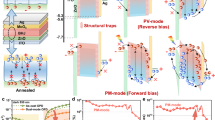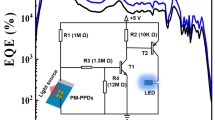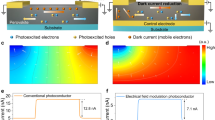Abstract
Broadband organic photodetectors (OPDs) can be integrated into various wearable devices and show great application potential in health monitoring and other fields. Here, we demonstrated high-performance broadband photomultiplication-type OPDs (PM-OPDs) based on MoO3 trapping electron-assisted hole tunneling injection mechanism with small-molecule lead (II) phthalocyanine (PbPc) and C70 fullerene as the donor and acceptor, respectively. In order to control the crystal phase structure formed by PbPc molecules, we prepared PbPc:C70 bulk heterojunction (BHJ) and PbPc/C70 planar heterojunction (PHJ) devices. It can be seen that the PHJ device exhibits stronger near-infrared (NIR) absorption characteristics, which is more conducive to the formation of the triclinic phase structure of the PbPc molecule. We further prepared flat panchromatic PM-OPDs in the range of 300–1000 nm by using materials (PbPc and SubPc) with absorption complementary characteristic as the active layers and PHJ/BHJ hybrid heterojunction structure. The external quantum efficiency of the resulting panchromatic PM-OPDs exceeds 1000% in the whole spectral response range under −8 V reverse bias. Finally, we prepared flexible panchromatic PM-OPDs on polyethylene terephthalate substrate and successfully realized the detection of the human pulse signal. This work provides a new strategy for obtaining high-performance panchromatic PM-OPDs by designing device structures and selecting appropriate materials.

摘要
宽带有机光电探测器(OPDs)可以集成到各种可穿戴设备中, 在健康监测等领域显示出巨大的应用潜力. 这里, 我们以酞菁铅(PbPc)和富勒烯(C70)小分子分别作为给体和受体, 基于MoO3俘获电子辅助空穴隧道注入的机制实现了高性能宽带倍增型有机光电探测器(PMOPDs). 为了控制PbPc分子的晶相结构, 我们分别制备了PbPc:C70体异质结(BHJ)和PbPc/C70平面异质结(PHJ)器件. 可以看出, PHJ器件表现出更强的近红外吸收特性, 即更有利于PbPc分子形成三斜相结构. 我们进一步使用具有吸收互补特性的材料(PbPc和SubPc)作为有源层, 采用PHJ/BHJ混合异质结结构, 制备了在300–1000 nm范围内平坦的全色PM-OPDs. 在−8 V反向偏压下, 制得的全色PM-OPDs在整个光谱响应范围内的外量子效率都超过1000%. 最后, 我们在聚对苯二甲酸乙二醇酯基板上制备了柔性全色PM-OPDs, 并成功地实现了人体脉搏信号的检测. 本文通过设计器件结构和选择合适的材料, 为获得高性能全色PM-OPDs提供了一种新策略.
Similar content being viewed by others
References
Liu X, Lin Y, Liao Y, et al. Recent advances in organic near-infrared photodiodes. J Mater Chem C, 2018, 6: 3499–3513
Ren H, Chen JD, Li YQ, et al. Recent progress in organic photodetectors and their applications. Adv Sci, 2021, 8: 2002418
Wang C, Zhang X, Hu W. Organic photodiodes and phototransistors toward infrared detection: Materials, devices, and applications. Chem Soc Rev, 2020, 49: 653–670
Yang D, Ma D. Development of organic semiconductor photodetectors: From mechanism to applications. Adv Opt Mater, 2019, 7: 1800522
Yang W, Qiu W, Georgitzikis E, et al. Mitigating dark current for high-performance near-infrared organic photodiodes via charge blocking and defect passivation. ACS Appl Mater Interfaces, 2021, 13: 16766–16774
Rauch T, Böberl M, Tedde SF, et al. Near-infrared imaging with quantum-dot-sensitized organic photodiodes. Nat Photon, 2009, 3: 332–336
Huang J, Lee J, Vollbrecht J, et al. A high-performance solution-processed organic photodetector for near-infrared sensing. Adv Mater, 2020, 32: 1906027
Wu Z, Yao W, London AE, et al. Temperature-dependent detectivity of near-infrared organic bulk heterojunction photodiodes. ACS Appl Mater Interfaces, 2017, 9: 1654–1660
Liu J, Jiang J, Wang S, et al. Fast response organic tandem photodetector for visible and near-infrared digital optical communications. Small, 2021, 17: 2101316
Gielen S, Kaiser C, Verstraeten F, et al. Intrinsic detectivity limits of organic near-infrared photodetectors. Adv Mater, 2020, 32: 2003818
Zhao Z, Liu B, Xie C, et al. Highly sensitive, sub-microsecond polymer photodetectors for blood oxygen saturation testing. Sci China Chem, 2021, 64: 1302–1309
Xie B, Chen Z, Ying L, et al. Near-infrared organic photoelectric materials for light-harvesting systems: Organic photovoltaics and organic photodiodes. InfoMat, 2020, 2: 57–91
Li Q, Guo Y, Liu Y. Exploration of near-infrared organic photodetectors. Chem Mater, 2019, 31: 6359–6379
Li N, Mahalingavelar P, Vella JH, et al. Solution-processable infrared photodetectors: Materials, device physics, and applications. Mater Sci Eng-R-Rep, 2021, 146: 100643
Menke SM, Pandey R, Holmes RJ. Tandem organic photodetectors with tunable, broadband response. Appl Phys Lett, 2012, 101: 223301
Wang Y, Siegmund B, Tang Z, et al. Stacked dual-wavelength near-infrared organic photodetectors. Adv Opt Mater, 2021, 9: 2001784
Strassel K, Kaiser A, Jenatsch S, et al. Squaraine dye for a visibly transparent all-organic optical upconversion device with sensitivity at 1000 nm. ACS Appl Mater Interfaces, 2018, 10: 11063–11069
Kim JH, Liess A, Stolte M, et al. An efficient narrowband near-infrared at 1040 nm organic photodetector realized by intermolecular charge transfer mediated coupling based on a squaraine dye. Adv Mater, 2021, 33: 2100582
Li L, Zhang F, Wang J, et al. Achieving EQE of 16,700% in P3HT: PC71BM based photodetectors by trap-assisted photomultiplication. Sci Rep, 2015, 5: 9181
Yang K, Zhao Z, Liu M, et al. Highly sensitive broadband photomultiplication type all-polymer photodetectors and their applications in optical pulse counting. J Mater Chem C, 2022, 10: 10888–10894
Liu M, Fan Q, Yang K, et al. Broadband photomultiplication-type polymer photodetectors and its application in light-controlled circuit. Sci China Chem, 2022, 65: 1642–1649
Zhao Z, Liu B, Xu C, et al. Highly stable photomultiplication-type organic photodetectors with single polymers containing intramolecular traps as the active layer. J Mater Chem C, 2022, 10: 7822–7830
Guo F, Yang B, Yuan Y, et al. A nanocomposite ultraviolet photodetector based on interfacial trap-controlled charge injection. Nat Nanotech, 2012, 7: 798–802
Wang J, Chen SC, Yin Z, et al. Broadband organic photodetectors based on ternary blend active layers with enhanced and spectrally flat response. J Mater Chem C, 2020, 8: 14049–14055
Guo D, Yang L, Zhao J, et al. Visible-blind ultraviolet narrowband photomultiplication-type organic photodetector with an ultrahigh external quantum efficiency of over 1 000 000%. Mater Horiz, 2021, 8: 2293–2302
Kim J, Kang M, Lee S, et al. Interfacial electrostatic-interaction-enhanced photomultiplication for ultrahigh external quantum efficiency of organic photodiodes. Adv Mater, 2021, 33: 2104689
Campbell IH, Crone BK. A near infrared organic photodiode with gain at low bias voltage. Appl Phys Lett, 2009, 95: 263302
Luo X, Lv W, Du L, et al. Insight into trap state dynamics for exploiting current multiplication in organic photodetectors. Phys Status Solidi RRL, 2016, 10: 485–492
Kublitski J, Fischer A, Xing S, et al. Enhancing sub-bandgap external quantum efficiency by photomultiplication for narrowband organic near-infrared photodetectors. Nat Commun, 2021, 12: 4259
Melville OA, Lessard BH, Bender TP. Phthalocyanine-based organic thin-film transistors: A review of recent advances. ACS Appl Mater Interfaces, 2015, 7: 13105–13118
Zhao W, Mudrick JP, Zheng Y, et al. Enhancing photovoltaic response of organic solar cells using a crystalline molecular template. Org Electron, 2012, 13: 129–135
Kim TM, Kim HJ, Shim HS, et al. The epitaxial growth of lead phthalocyanine on copper halogen compounds as the origin of templating effects. J Mater Chem A, 2014, 2: 8730–8735
Wang X, Li H, Su Z, et al. Efficient organic near-infrared photodetectors based on lead phthalocyanine/C60 heterojunction. Org Electron, 2014, 15: 2367–2371
Choi MS, Chae S, Kim HJ, et al. Control of crystallinity in PbPc:C60 blend film and application for inverted near-infrared organic photodetector. ACS Appl Mater Interfaces, 2018, 10: 25614–25620
Su Z, Hou F, Wang X, et al. High-performance organic small-molecule panchromatic photodetectors. ACS Appl Mater Interfaces, 2015, 7: 2529–2534
Vasseur K, Broch K, Ayzner AL, et al. Controlling the texture and crystallinity of evaporated lead phthalocyanine thin films for near-infrared sensitive solar cells. ACS Appl Mater Interfaces, 2013, 5: 8505–8515
Choi MS, Lee S, Kim HJ, et al. Inverted near-infrared organic photodetector with oriented lead (II) phthalocyanine molecules via substrate heating. Org Electron, 2018, 61: 164–169
Hammond WT, Mudrick JP, Xue J. Balancing high gain and bandwidth in multilayer organic photodetectors with tailored carrier blocking layers. J Appl Phys, 2014, 116: 214501
Kim YH, Kim JS, Kim WM, et al. Realizing the potential of ZnO with alternative non-metallic Co-dopants as electrode materials for small molecule optoelectronic devices. Adv Funct Mater, 2013, 23: 3645–3652
Somashekharappa GM, Govind C, Pulikodan V, et al. Unsymmetrical squaraine dye-based organic photodetector exhibiting enhanced near-infrared sensitivity. J Phys Chem C, 2020, 124: 21730–21739
Wang M, Li YZ, Chen HC, et al. Unveiling the underlying mechanism of record-high efficiency organic near-infrared photodetector harnessing a single-component photoactive layer. Mater Horiz, 2020, 7: 1171–1179
Guo D, Xu Z, Yang D, et al. Structure design and performance of photomultiplication-type organic photodetectors based on an aggregation-induced emission material. Nanoscale, 2020, 12: 2648–2656
Yang L, Guo D, Li J, et al. Low-cost copper electrode for high-performance panchromatic multiplication-type organic photodetectors with optical microcavity effect. Adv Funct Mater, 2022, 32: 2108839
Shi XB, Hu Y, Wang B, et al. Conductive inorganic-organic hybrid distributed bragg reflectors. Adv Mater, 2015, 27: 6696–6701
Zhao F, Luo X, Liu J, et al. Toward high performance broad spectral hybrid organic-inorganic photodetectors based on multiple component organic bulk heterojunctions. J Mater Chem C, 2016, 4: 815–822
Liu SW, Lee CC, Yuan CH, et al. Transparent organic upconversion devices for near-infrared sensing. Adv Mater, 2015, 27: 1217–1222
Acknowledgements
This work was supported by the National Natural Science Foundation of China (U21A6002), Guangzhou Science and Technology Plan Project (202102080332), Guangdong Province Basic and Applied Basic Research Fund Project (2021A1515012560), Guangdong Provincial Key Laboratory of Luminescence from Molecular Aggregates, China (2019B030301003) and the Research Project of Jilin Province (20191102006YY). Guo D is thankful for the support from China Postdoctoral Science Foundation (2022M711193).
Author information
Authors and Affiliations
Contributions
Author contributions Guo D carried out the device experiments, prepared the figures and wrote the paper. Yang D, Wang L, and Ma D provided the overall concept and revised the manuscript. Yang L, Li J, He G, Zheng J, Tao S, and Vadim A classified and analyzed the reference papers. All authors participated in the general discussion.
Corresponding authors
Ethics declarations
Conflict of interest The authors declare that they have no conflict of interest.
Additional information
Supplementary information Supporting data are available in the online version of the paper.
Dechao Guo received his PhD degree from the South China University of Technology in 2020. Now he continues his postdoctoral research at the South China University of Technology with Prof. Dongge Ma. He is majored in organic semiconductors and devices, including organic LEDs, organic photodetectors and their applications.
Dezhi Yang received his PhD degree from Changchun Institute of Applied Chemistry, Chinese Academy of Sciences (CAS) in 2012. Then he worked at Changchun Institute of Applied Chemistry as an assistant research fellow. In 2016, he joined the South China University of Technology as an associate researcher. At present, his research mainly focuses on the structural design and mechanism research of organic photodetectors and organic upconversion devices.
Linge Wang received his PhD degree in chemistry from the Institute of Chemistry, CAS in 2003. He worked at CAS and the University of Sheffield before August 2012, and then he was appointed as a full professor of the South China University of Technology. His research focuses on soft matter & hybrid materials, particularly on polymer nanofibers, polymer vesicles, tissue engineering, and advanced optical film.
Dongge Ma received his PhD degree from Jilin University in 1995. He worked as a visiting professor and research fellow at the University Federal do Paranal, Brazil, and Durham University and St. Andrews University, UK, and then he joined Changchun Institute of Applied Chemistry, as a professor in 2001. In 2016, he joined the South China University of Technology. Currently, his research focuses on organic semiconductor optoelectronic devices, including organic LEDs and organic photodetectors.
Rights and permissions
About this article
Cite this article
Guo, D., Yang, L., Li, J. et al. Panchromatic photomultiplication-type organic photodetectors with planar/bulk heterojunction structure. Sci. China Mater. 66, 1172–1179 (2023). https://doi.org/10.1007/s40843-022-2241-3
Received:
Accepted:
Published:
Issue Date:
DOI: https://doi.org/10.1007/s40843-022-2241-3




